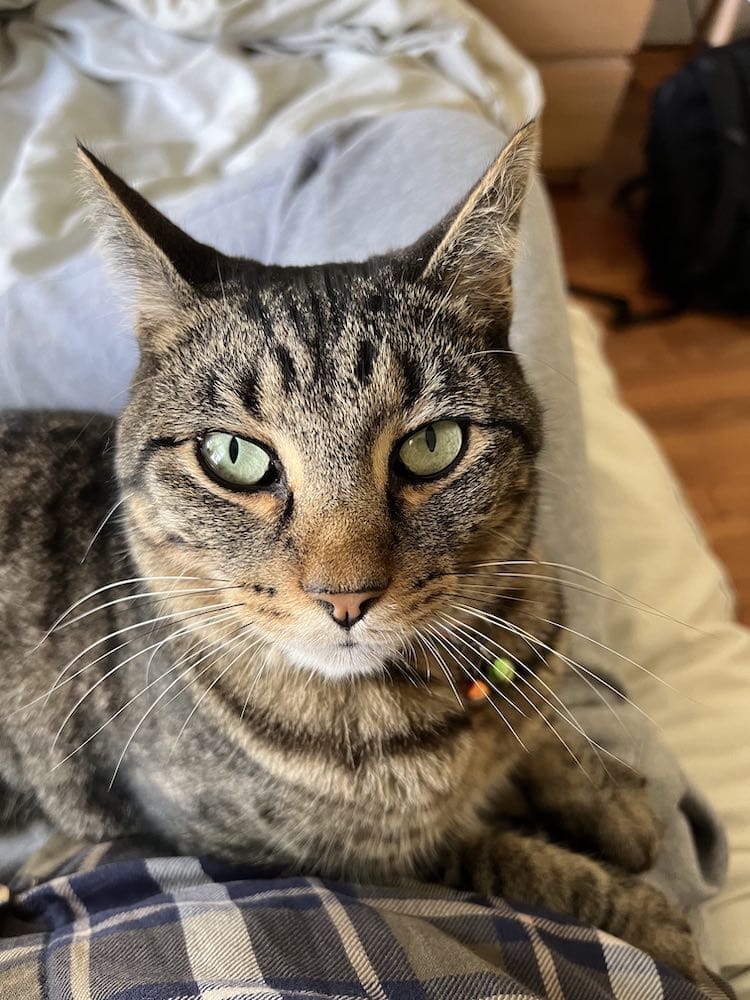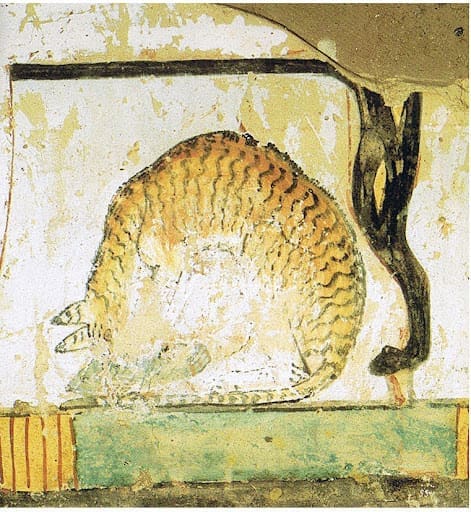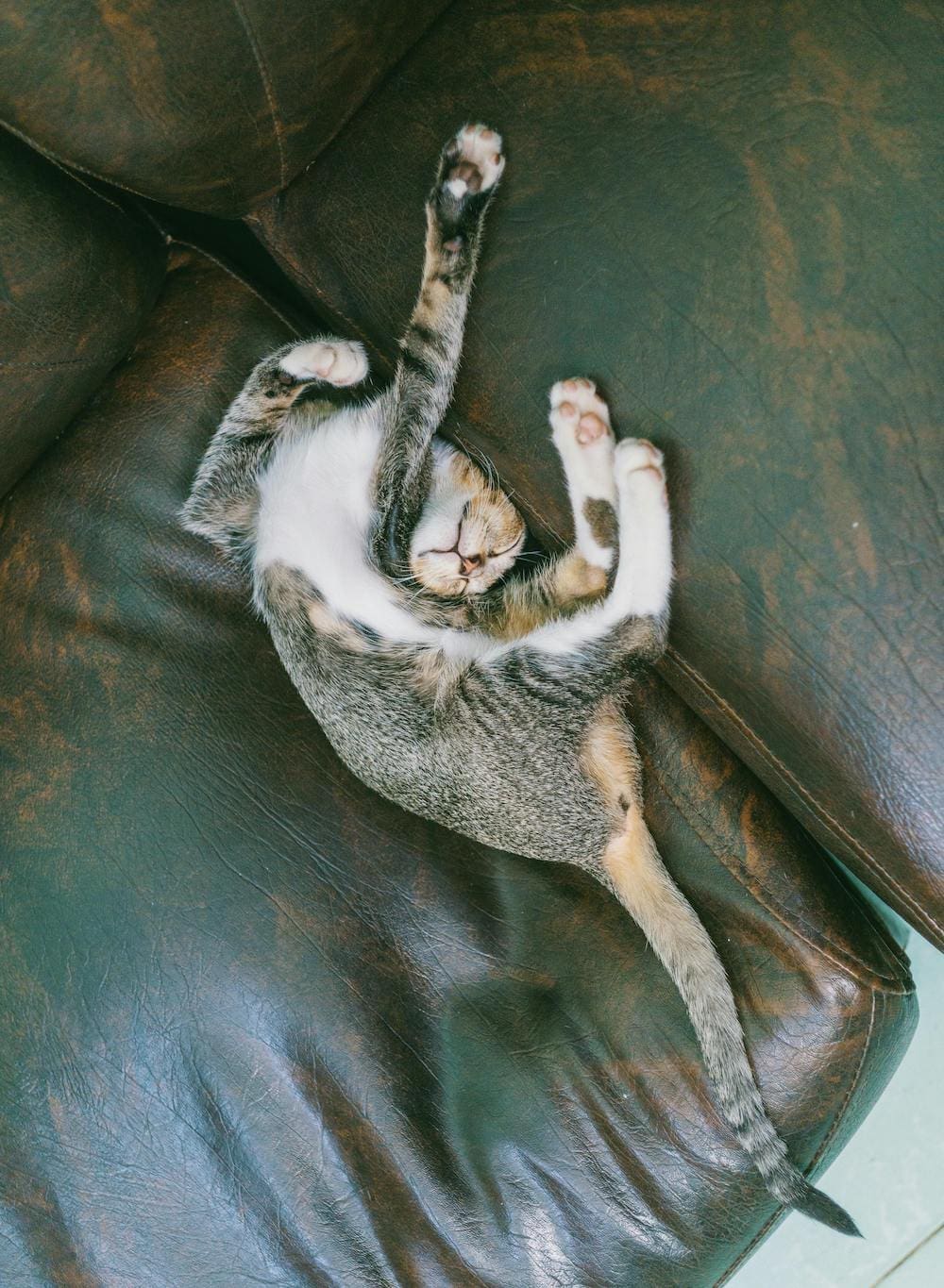What mammal makes a mysterious sound that scientists can’t figure out, can jump straight up to a height eight times their body length, and loves us when we love them?
Felis catus, the mostly tame, sometimes feral, house cat!

Photo by Maya Dutta
Cats domesticated us humans around 7500 BCE, once we began growing grain – and we needed someone to control the annoying mice that ate it. Cats found this to be a pretty good deal and the feeling was mutual. The relationship worked so well that Felis catus became one of the top ten most populous mammals on Earth, with approximately 700 million of them today.
By the way, if you want to sound cool when there’s a group of them around, you may refer to the numerous felines as a clowder or glaring of cats (as in, “Look, everyone – there’s a clowder of cats!”).

dating to the 15th century BC
(Photo: Public domain, via Wikimedia Commons)
Not all is rosy in mondo catus, sadly. They are so adaptable, brought to all continents except Antarctica (mostly by humans in boats), that cats are among the most invasive of species. They sometimes wind up in places free of natural predators, and their proliferation is fed by eating billions of birds, mammals, and reptiles, even causing an occasional extinction. (Then again, who are we Homo sapiens to pass judgment on other “invasive” species?)
Yet, undeterred by dark sides, people around the world are crazy about their cats. We will go to great lengths to make them happy. See, for example, this Kickstarter Shru Cat Companion crowdfunding campaign: https://www.kickstarter.com/projects/1046165765/egg-the-intelligent-cat-companion (scroll down, watch the video, and try to contain your excitement).
The cat-toy inventor asked for a $15,000 investment, but cat lovers showed their love by sending Shru $170,779 for an exotic cat toy that does . . . well, I’ll let you figure that one out. In the meanwhile thousands of non-profits run crowdfunders to conduct activities like feeding children and turning deserts green again, among many other urgent things – and their average take is only $9,237. Such oddly-placed power of cat fervor is depressingly impressive (though it’s not the cats’ fault).
But I digress.
Cats are indeed remarkable animals. They can jump to heights over eight times their own body length (that would be almost five stories high for a six-foot human), always land on their feet, and display properties of both solids and liquids. That’s right, given a definition of a liquid as a substance that conforms to the shape of a container, cats fill that bill to a T (or a Q or a Z).

Cats have more vertebrae than most mammals, and their intervertebral discs are elastic and springy. So cats can contort into an amazing variety of liquid-esque positions. And even more importantly, those spinal discs alternately expand and compress as the animal runs, which conserves energy and provides extra propulsion for speeds of up to 30 miles per hour (or 48 km/h).
Although cat behavioral and psychological scientists are a few years behind their canine counterparts, it is lately becoming scientifically apparent how intelligent and emotionally responsive cats are (of course, cat owners have known this forever). They just show it differently from dogs or other animals:
Yes! Cats do love their humans, even if sometimes they have a funny way of showing it. In fact, they form strong attachments to their owners and display their emotions very similar to humans.
Just like people, cats can show their love through understanding and concern for others. In some instances, they have been known to risk their lives for their owners, protecting them from dangers like poisonous snakes or other hazards. Cats can also detect when their owner is upset and will often console them or, in some cases, even lick away their tears! Some cases exist where an owner left or passed away, and the cat exhibited signs of distress like sitting and meowing at the owner’s bedroom door, going into hiding, even refusing to eat. But perhaps some of the most incredible evidence that cats do get attached to their owners is in the cases where cats have traveled hundreds upon hundreds of miles to places they’ve never been in order to find their person.
https://www.azpetvet.com/cat-owner-love/

How they find their distant people, nobody knows. You may enjoy some more long-distance cat-travel stories at https://www.pets4homes.co.uk/pet-advice/10-amazing-cats-that-travelled-vast-distances-to-be-with-their-owners.html.
Finally, there’s purring, a sound that science still can’t quite figure out. It turns out that cats purr for all kinds of reasons other than that they’re happy to be on our laps. This video tells the story:
Intriguing cat facts and tales could go on forever, but for now let’s travel onward together on the road to purr-fect purr-ful bliss,
Adam
P.S. If you have access to Netflix, there’s a fascinating video entitled “Inside the Mind of a Cat.” You can train cats to do all kinds of amazing tricks when you know how. Note that they’re training you as much as you’re training them!

Adam Sacks is a Co-Founder and former Executive Director of Biodiversity for a Livable Climate (Bio4Climate). He has had careers in education, holistic medicine, computer technology, politics, and advocacy. A climate activist for the past 25 years, he has been studying and writing about Holistic Management since 2007. His primary goal is the regeneration of biodiversity and a livable planet.
Sources and Further Reading:
https://www.nationalgeographic.com/animals/mammals/facts/domestic-cat
https://www.pets4homes.co.uk/pet-advice/10-amazing-cats-that-travelled-vast-distances-to-be-with-their-owners.html
https://www.cantonrep.com/news/20191121/missing-cat-travels-1200-miles-to-be-reunited-with-its-owner-after-5-years
https://www.azpetvet.com/cat-owner-love/
https://en.wikipedia.org/wiki/Cat
https://www.dailypaws.com/cats-kittens/health-care/how-high-can-cats-jump








